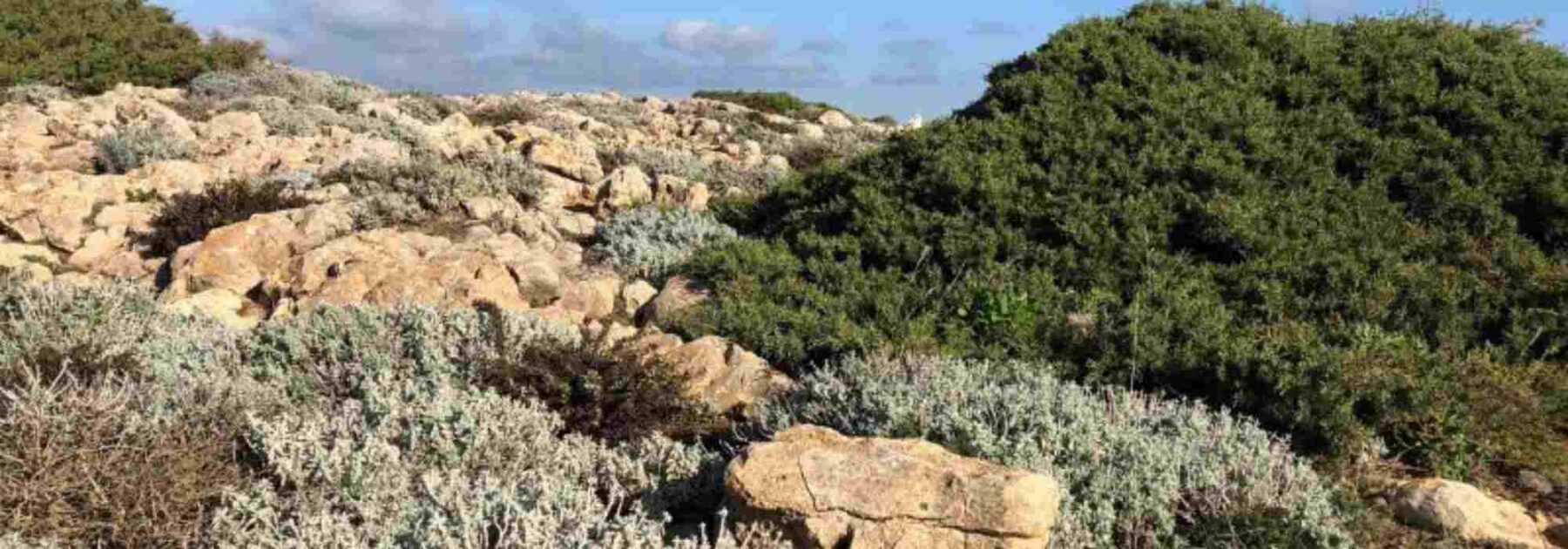
How to Design a Garden in a Garrigue Landscape?
Practical Tips and Plant Palette for a Characterful Garden in Garrigue Soil
Contents
In the south of France, in the garrigue region, creating a garden requires specific conditions to ensure it thrives. The typical garrigue vegetation, composed of shrubs and small trees, grows on limestone and poor soils. The climate is harsh, with intense summer heat and often cold, windy winters. Nevertheless, the garrigue regions allow for the creation of beautiful gardens, which are currently very trendy due to their lack of need for watering: they are fragrant gardens that highlight the wild beauty of garrigue plants.
How to design a garden in these challenging growing conditions, taking into account the specificities of the soil and climate? We explain how to succeed with your garden if you live in these southern regions, by choosing suitable plants and harmoniously arranging the spaces.
→ Discover our garrigue garden range in our online catalogue.
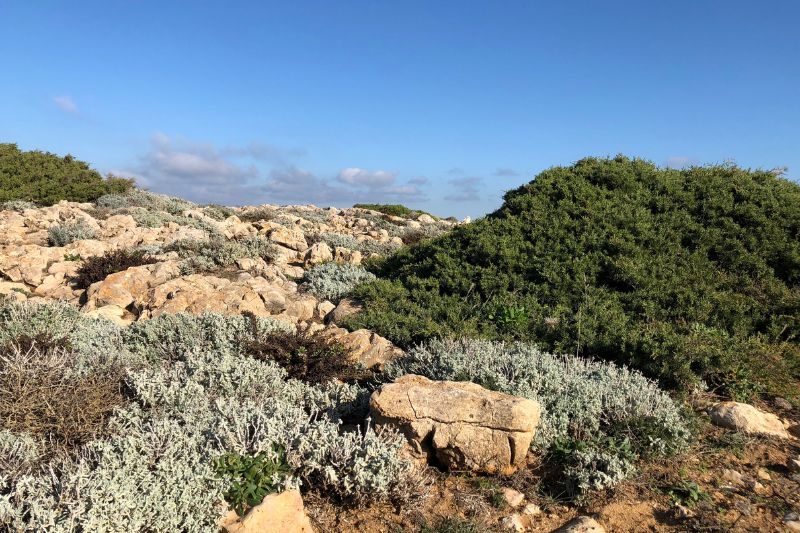
The garrigue: an exceptional landscape to be tamed in gardens
Specificities and Constraints of the Garrigue The garrigue is a unique Mediterranean landscape characterised by its dry, rocky terrain and aromatic vegetation. This ecosystem, found primarily in southern France, is shaped by specific climatic conditions and human activity. Here are some key features and challenges associated with the garrigue: 1. **Climate**: The garrigue thrives in a Mediterranean climate, with hot, dry summers and mild, wet winters. This seasonal contrast influences the types of plants that can survive here. 2. **Soil**: The soil is typically shallow, rocky, and poor in nutrients. It drains quickly, making it challenging for many plants to establish deep root systems. 3. **Vegetation**: The garrigue is dominated by hardy, drought-resistant plants such as thyme, rosemary, lavender, and evergreen oaks. These plants are well-adapted to the harsh conditions and often release aromatic oils that deter herbivores. 4. **Biodiversity**: Despite its seemingly barren appearance, the garrigue supports a diverse range of flora and fauna. It provides habitat for insects, reptiles, birds, and small mammals, many of which are specially adapted to this environment. 5. **Fire Risk**: The dry climate and dense, flammable vegetation make the garrigue highly susceptible to wildfires. These fires, while destructive, also play a role in the ecosystem's regeneration by clearing old growth and encouraging new plant life. 6. **Human Impact**: Historically, human activities such as grazing, agriculture, and deforestation have shaped the garrigue. Overgrazing and land abandonment can lead to soil erosion and loss of biodiversity, while careful management can help preserve this unique landscape. 7. **Conservation**: Protecting the garrigue involves balancing human use with ecological preservation. Sustainable practices, such as controlled grazing and fire management, are essential to maintaining its health and biodiversity. The garrigue is a resilient yet fragile ecosystem that requires careful stewardship to ensure its survival for future generations. Its unique beauty and ecological importance make it a valuable part of the Mediterranean landscape.
The garrigue is a typical landscape of several regions in the south of France, from the Alpes-de-Haute-Provence to the eastern Pyrenees: the Provençal hinterland, Lower Languedoc, and the Cévennes, extending to the borders of the eastern Pyrenees. It is mainly found in the departments of Gard and Hérault, but also in Vaucluse, southern Ardèche, and Drôme. Gardens located in these areas inherit karstic limestone soils, which are poor, shallow, and often exposed to rock, making them particularly challenging, as it requires finding vegetation that can thrive in such conditions, especially at the root level.
Another characteristic of these garrigue and causses areas is that they experience a very unique climate within the southern regions: not only is the climate extremely hot and dry in summer, with recent years seeing repeated and prolonged heatwaves, but it also receives very little rainfall. The temperature range is more extreme here than elsewhere, with cold winters and regularly sub-zero temperatures, unlike areas closer to the coast. Add to this the strong gusts of wind, hot (such as the autan wind or foehn effect) which exacerbate the summer dryness, or cold in winter and spring, like the mistral, tramontane, cers, or gregale winds in Provence and Roussillon.
The garrigue and its rocky hills thus form an arid land considered harsh. These are mountainous terrains reaching up to 1000 metres in altitude, rough and stony, known for being difficult and inhospitable at first glance, as they become as hard as stone in summer.
N.B.: The garrigue differs from the maquis due to its limestone soil, whereas the maquis has acidic soil.
→ Learn all about the garrigue, its etymology, geology, and history on the wikigarrigue website.
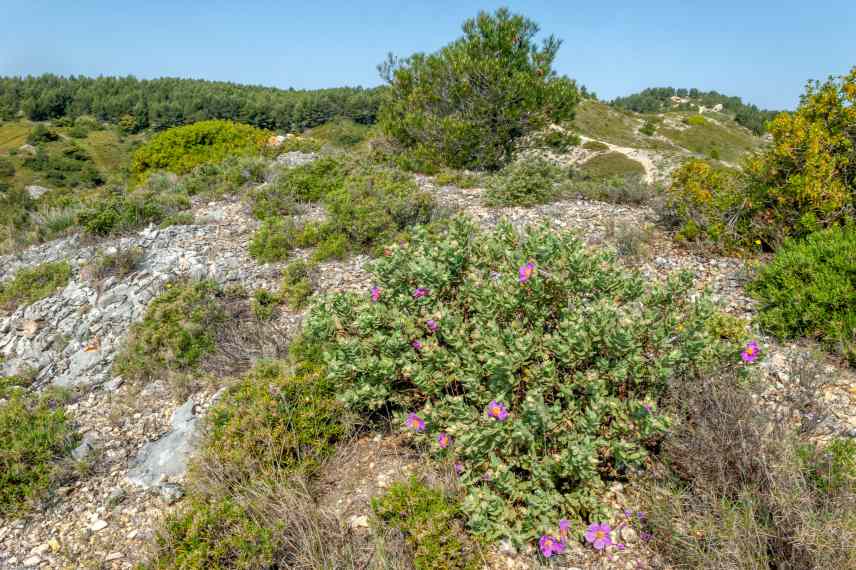
The garrigue in spring: a landscape of small hills or plateaus covered with low, fragrant vegetation, where rock is omnipresent.
The Mediterranean Garden Style in Garrigue Areas
On dry, chalky, and shallow soils of the garrigue, two priorities emerge: selecting calcicole and xerophile plants that naturally thrive in these arid environments and can withstand the climate (see below), but also adapting the style you wish to give to your outdoor space. It is unthinkable to turn this garden into an area where lush lawns and opulent flowerbeds take centre stage. Instead, consider embracing a local, distinctive garden style where the mineral elements create a strong visual impact, perfectly harmonising with a subdued plant palette featuring greyish tones, occasional blooms, and low-growing ground covers.
Depending on your region, your garden may be situated on a plateau, rolling hills, or flat terrain. A sloping garden can be more easily transformed into a restanque-style garden, with its characteristic stone terraces typical of the south of France. On flat areas, you can create a dry garden or even a gravel garden. Finally, make the most of the dry, stony ground to create sunny rockeries and embankments here and there.
Always aim to maintain the idea of a garden that opens onto the landscape: in the spirit of a Mediterranean or Provençal garden, but with a much more natural style that incorporates the surrounding views.
→ Also read our feature How to create a garrigue atmosphere? and our articles on designing a restanque garden and a gravel garden, and creating a rockery; our tips for success.
The Perfect Plants for a Mediterranean Garden
Your garden will be in bloom in spring, more dormant in summer when plants enter a kind of dormancy to cope with drought, often “reblooming” in autumn with the help of seasonal rains. They need to be robust, resistant to cold, drought, and intense heat, as well as to significant temperature fluctuations. On these shallow limestone soils, you’ll find almost everywhere an evergreen vegetation (with persistent foliage), tough leaves, numerous low-growing woody plants, bulbous plants, and aromatic plants…
Trees: They Provide Shade
Trees must be able to withstand prolonged droughts and rocky soils. However, as you’ll notice when wandering through these inland areas, there’s no trace of olive trees, which are often not hardy enough for these very open landscapes, exposed to cold winter winds. While the olive tree reigns in Provence, evergreen oaks are the kings of the garrigue. You’ll use them as focal points to create structure and provide essential shade: the kermes oak (the most emblematic, its name derived from the old Provençal word garric, which gave rise to the term garrigue), the holm oak and the downy oak. Among the trees most resistant to both cold and heat, you can also rely on the European nettle tree (Celtis australis) or the Italian cypress.
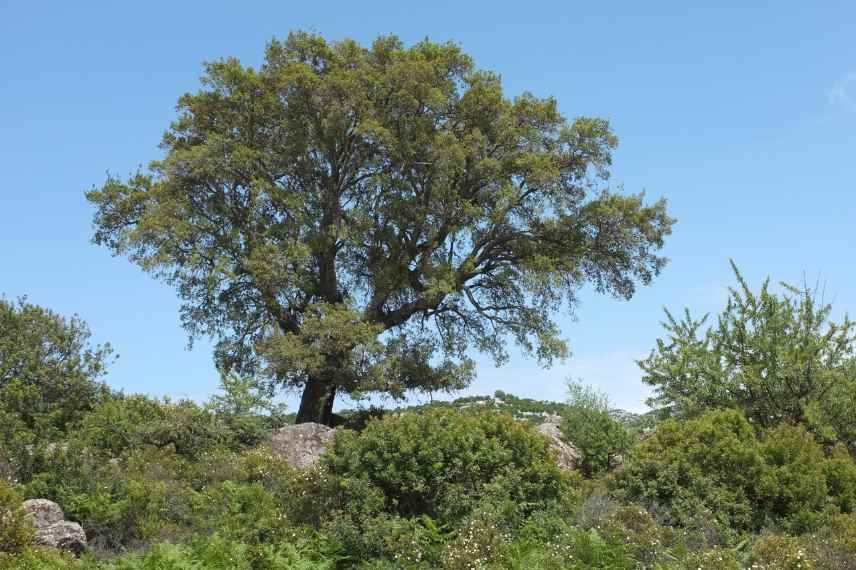
Quercus ilex (holm oak)
Shrubs: Simplicity, Colours, and Scents
These are the plants that truly capture the essence of the garrigue! A lower layer of vegetation will dominate the rest of the garden, as these shrubs and small evergreen trees have developed strategies to draw the necessary resources for their growth in this infertile environment. Naturally, you’ll find all the typical garrigue plants like the myrtle, as well as the viburnum and Portuguese laurel. Priority should be given to aromatic plants, including all varieties of thyme, sage, and rosemary, which can create stunning displays with their diverse foliage and growth habits. Their garrigue companions include the rockroses – Cistus albidus (white-leaved rockrose), Cistus populifolius, Cistus salviifolius, not forgetting the lavenders, which are also queens here if well sheltered, the Jerusalem sage, and the germanders. Also part of the landscape are the cade juniper and the lavender cotton.
Among the taller species that thrive in shallow soils, you’ll also find the sea buckthorn, the strawberry tree, the Montpellier maple, the Rhamnus alaternus, or the mock privet (Phillyrea).
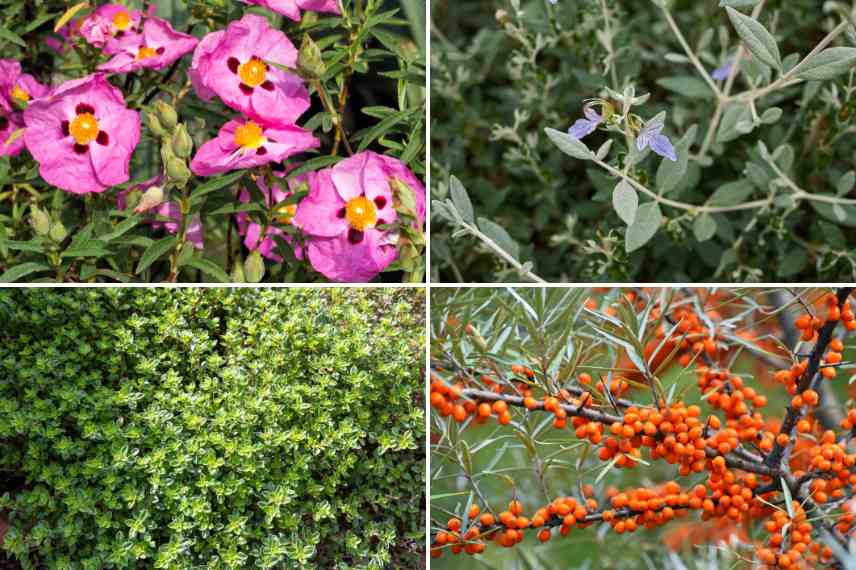
Rockrose, germander, thyme, and sea buckthorn
Perennials and Grasses: A Wild Touch
Priority goes to dryland plants, but the first instinct is still to draw inspiration from the local flora, which knows how to withstand both heat and cold. Indigenous plants are indeed the ones that will thrive best in the harsh conditions of poor, rocky soil, and they stand out for their wild and natural appearance: Narcissus assoanus or garrigue narcissus, garrigue iris (Iris lutescens), Aphyllanthes monspeliensis (Montpellier aphyllanthes, a small blue carnation growing in tight clumps), Saponaria ocymoides for planting in walls, Lupinus micranthus, Anthericum ramosum (branched asphodel), the Aster linosyris. Of course, euphorbias like the tree spurge or Euphorbia characias, as well as yarrows and cupid’s dart, will also have their place.
Amidst often low-growing, spreading, and prostrate plants, it’s interesting to see some more upright plants emerge, such as the vertical flower spikes of giant fennel or Asphodelus fistolus or Asphodelus ramosus, as well as dyeing and medicinal plants like the chamomiles.
As for lawns, it’s easy to understand that it’s best to keep them to a minimum. If you wish to attempt one, it should be limited to areas around the house, but the focus should be on replacing it with lawn alternatives, ground covers that are far less thirsty: read our articles on the subject, such as Lawn Alternatives: 10 Ground Covers to Replace Grass and Lawn Alternative: Planting Creeping Thyme.
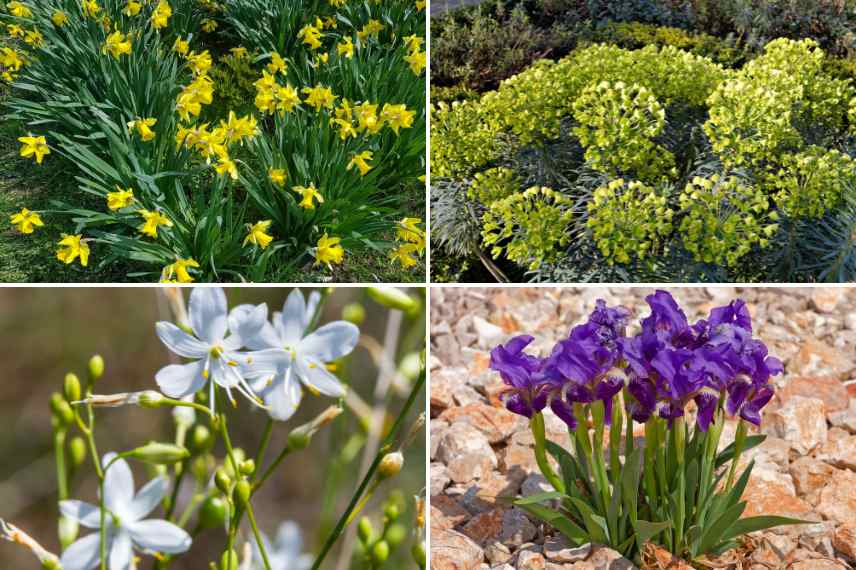
Narcissus assoanus, Euphorbia characias, Anthericum ramosum, and Iris lutescens
→ Also read: Essential Garrigue Plants, 5 Shrubs for Rocky Soils, and Trees for Rocky Soils.
Landscaping
Adding a few decorative elements is more than useful in this garden now planted with suitable vegetation. It’s the finishing touch to seamlessly integrate outdoor spaces with the garrigue atmosphere.
Given the sunny climate, we focus on creating shaded relaxation areas. A shaded stone courtyard adorned with beautiful terracotta jars or pots (frost-resistant!), a wrought-iron arbour where you can enjoy lunch, blending perfectly with the ochre tones of the stone. Keep in mind the codes of the garrigue: dry stone, ochre, and greyish hues.
Explore the dry stone technique! Start with an existing stone shelter or ruin in the garden, or build a low wall or terraces using rubble and stones collected from the ground, where you can plant trailing plants. Alternatively, on a larger plot, consider a typical regional structure (Cévennes mazet with tiled roofing, a causse caselle…) to use as a shed or storage space.
In the same mineral spirit, make use of the abundance of stones found on your land to create a calade, a kind of tapestry made of small flat stones, sometimes two-toned. It will look particularly striking near the areas closest to the house.
Finally, gravel pathways will subtly wind through the plants, which will soon encroach on the edges of the path.
Also, read my advice on Terracotta in the garden: our ideas and inspirations.
Here are some planting tips and recommendations:
- Preparing the ground is less demanding than one might think. Admittedly, stony soil with a thin layer of earth is not the easiest to work with (you may sometimes need a crowbar), but you obviously won’t replace the entire soil of a future garden. Depending on the proportion of bedrock in the area, you will base your plantings on the existing thin layer of topsoil. Once loosened, your soil should be sufficiently well-draining to accommodate xerophilic plants, and in any case, it will remain mostly stony and poor in structure. However, add a bit of soil to create a minimal planting basin. Do not amend it, as the plants that can grow there will be content with it.
- With the larger stones removed, create a clapas, or a dry stone wall.
- You will create a garden with character… and a garden without watering, requiring less maintenance. This does not mean you shouldn’t water in the first year—quite the opposite: read Sophie’s advice, who knows the subject well, in Creating a Garden Without Watering (or Almost).
- Planting in autumn allows garrigue plants to develop their root systems better and withstand summer heatwaves more effectively. Autumn and winter rains are indeed plentiful and ensure good establishment. The only exception would be plants that are borderline hardy for your zone.
- Plant densely, forming cushions of vegetation that will significantly limit “weeds”.
- Choose plants in small containers, which are much easier to establish properly in these challenging soils.
- Even more so than elsewhere, mulch your plants, but here use mineral mulches to avoid enriching the soil and to protect plants from winter moisture.
- In this dry garden, be vigilant about maintenance at the edges of the plot, which are sometimes neglected and highly flammable during heatwaves. Check out our articles Fire Risks: 10 Plants to Avoid in the Garden and 15 Pioneer Plants for a Garden More Resilient to Climate Extremes.
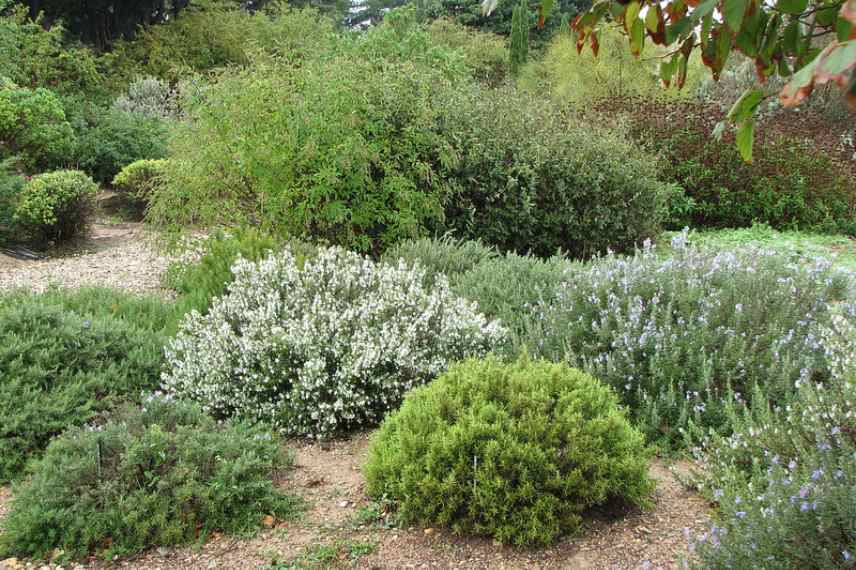
Collection of thymes at the Pépinières Filippi trial garden (© Sean A O’Hara)
- Subscribe!
- Contents
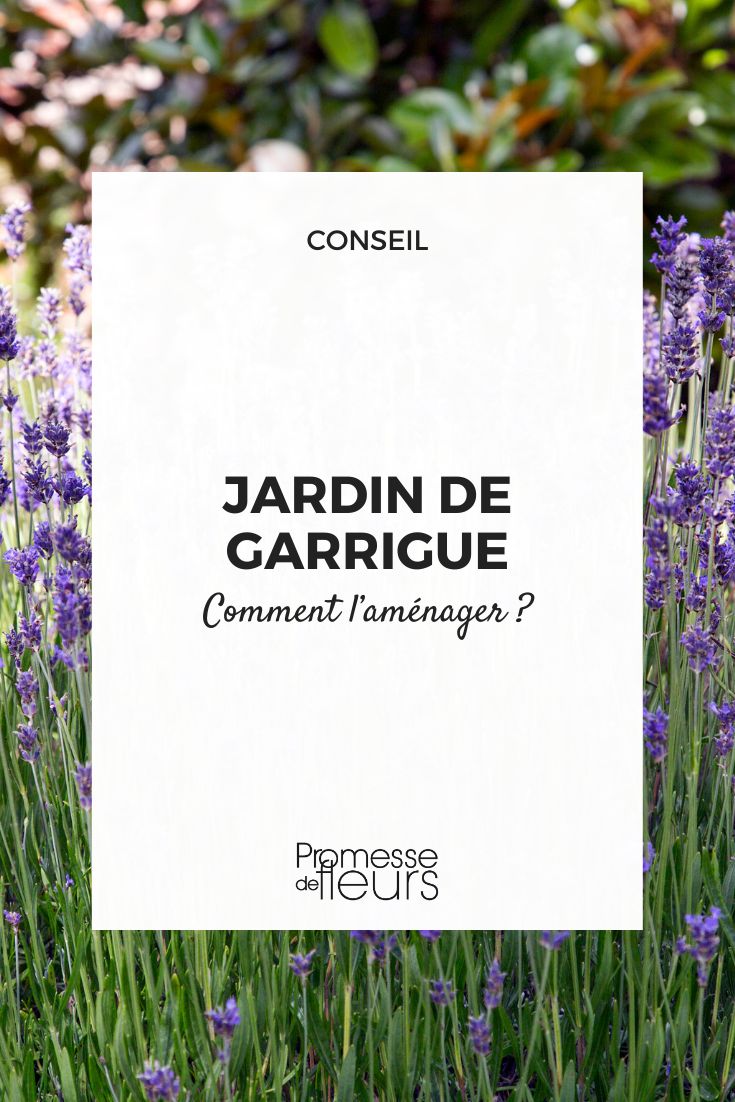


































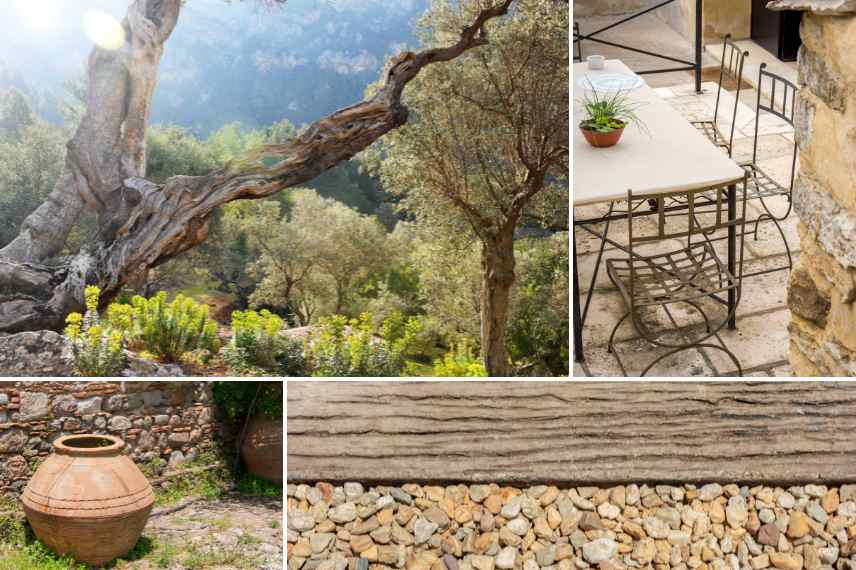
Comments